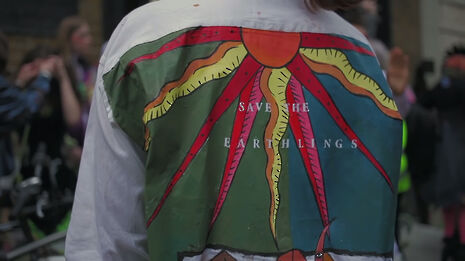Sustainable fashion, a year in
Sustainable fashion is better for the planet – but how easy is it to ditch fast fashion?

One year ago, ‘fast fashion’ meant nothing to me. But I’d felt its pervasive influence from my earliest summer shopping trips right up to my pre-freshers’ wardrobe revamp. It was in the context of sustainable fashion, fast fashion’s opposite, that I discovered its meaning – and I saw in this alternative a release from something which had been exerting an unacknowledged but enormous pressure on my buying choices, on my body image – and on the planet.
Fast fashion is the phenomenon fuelled by high-street clothes stores which makes clothes disposable, cast off every time the season changes. It results in an enormous amount of waste, plus emissions in production. The constantly changing trends which encourage us to buy more and more for less and less, too, bring the industry to rely on exploiting its most vulnerable workers to keep price tags at the absurdly low standard which we now expect. Sustainable fashion means opting out of the systems which perpetuate these harms by buying from sustainable brands (which use environmentally-friendly materials, and are designed to last virtually for life), shopping second-hand, and viewing clothes as staples which outlast seasonal trend changes. A sewing kit comes in handy, as does a group of friends who are willing to negotiate on borrowings and swaps. Organised clothes swaps, run by groups like Nu Wardrobe, as well as charity shop trips, are great ways to get the occasional newbie which fast fashion has inevitably conditioned us to crave.
Going sustainable as a new year’s resolution, I’ve actually never been happier – or calmer – in a high street store. Opting out of fast fashion has saved me countless hours of trawling on big shopping trips, on the lookout for the best and trendiest bargains. It’s removed the stress of jumping at sales and special offers. It’s drastically reduced the number of times I’ve felt upset or frustrated in a store fitting room because the latest New Look line is far more flattering on a mannequin.
“Depending on how much the conditioning got to you, too, it can be really hard to let go of fast fashion, especially for women”
At the same time as reducing the consumer demand which pushes exploitation of the planet and of the poorest workers, then, it’s also made fashion far less important in my life, even as it’s encouraged me to develop a clearer personal style from a tapestry of second-hand sources and to try new things when choice is limited. Whilst sustainable brands can’t always make up a wardrobe on a student budget, I’ve found brands like SolidariTee to be brilliant quality at reasonable prices. Whether it’s knowing that your money is going to support refugees (which SolidariTee’s profits do), or that more superficial buzz of finding Levi’s shorts for a fiver in the bargain box of a vintage store, there are perks of shopping sustainably which you don’t get in the hustle and pressure of fast fashion.
Getting out of the mindset of regularly craving new additions to my wardrobe was a big mental shift, but turned out to be remarkably easy after the first few steps. It’s about learning to love and work with what you’ve got. Almost a year in, I haven’t bought any new clothes, but I love the wardrobe I’ve constructed second-hand from Depop, clothes swaps, charity shops, and Facebook buy and sell groups.
It isn’t always that easy. May Week was low effort compared to sourcing shoes and underwear sustainably. Whilst tops, trousers, and even more challenging formal wear have been do-able, I haven’t really got sustainable strategies for knickers and socks, and I’m really just hoping the bras I have now last for ever. When I needed to replace the pair of everyday white trainers which were getting holes in the soles, I reluctantly headed to T.K.Maxx because they, at least, are counteracting the seasonal waste of fast fashion even if they’re not super sustainable on other counts. Sometimes it would just be nice to have some retail therapy before Bridgemas formal because you’ve worn all your other fancy items at least twice during the term. Sometimes you don’t have the energy for a hit-and-miss charity shop trip, or you can’t take the time out from work when a rare clothes swap is happening. Depending on how much the conditioning got to you, too, it can be really hard to let go of fast fashion, especially for women: I remember realising early on that what I was aiming for with my sustainable capsule wardrobe was far closer to that of my male friends; it’s more acceptable for them to rewear repeatedly, and everything is plain enough to work easily with everything else.
There are challenges, and there are intersections which can make sustainable fashion a lot harder (because of the time investment, the availability of different sizings, the expense of sustainable brands) for some consumers than others. But I am convinced that, when possible, it’s a liberating and rewarding lifestyle change. Only, that is, in the right culture – one where we compliment people on the outfit they’ve put together rather than the labels which comprise it, where we value getting your wear out of things, and where we’re impressed by recycling and innovation rather than sparkly disposability.
 Comment / Plastic pubs: the problem with Cambridge alehouses 5 January 2026
Comment / Plastic pubs: the problem with Cambridge alehouses 5 January 2026 News / Cambridge businesses concerned infrastructure delays will hurt growth5 January 2026
News / Cambridge businesses concerned infrastructure delays will hurt growth5 January 2026 News / New movement ‘Cambridge is Chopped’ launched to fight against hate crime7 January 2026
News / New movement ‘Cambridge is Chopped’ launched to fight against hate crime7 January 2026 News / AstraZeneca sues for £32 million over faulty construction at Cambridge Campus31 December 2025
News / AstraZeneca sues for £32 million over faulty construction at Cambridge Campus31 December 2025 Interviews / You don’t need to peak at Cambridge, says Robin Harding31 December 2025
Interviews / You don’t need to peak at Cambridge, says Robin Harding31 December 2025










